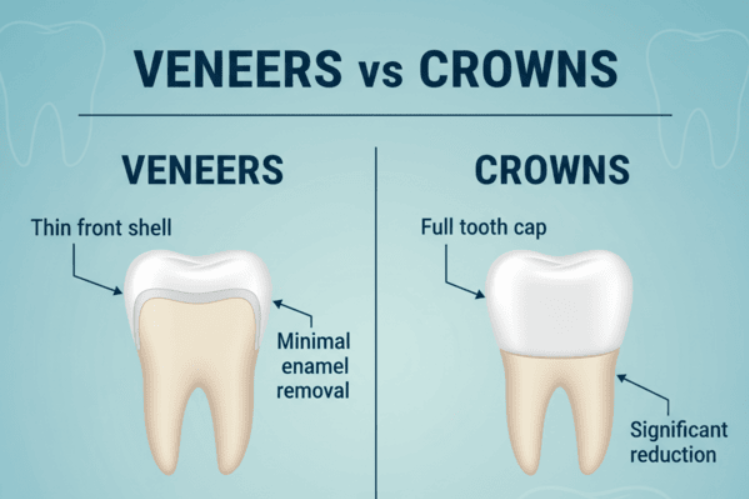
Table of Contents
- Veneers vs Crowns: What Are They?
- What Is a Veneer?
- The Difference Between Veneers and Crowns
- What Are the Pros and Cons of Veneers?
- What Are the Pros and Cons of Crowns?
- Crown vs Veneer Cost: What to Expect
- Cosmetic vs Restorative Treatment: Which Approach to Go For?
- When to Choose Veneer or Crown: Decision Factors
- Veneers vs Crowns: Maintenance, Longevity, and Tips
- Sample Cases: Veneers vs Crowns in Practice
- Veneers vs Crowns: Who Wins?
- FAQs
Veneers vs Crowns. Which one should you choose? That is an ongoing debate. People are a bit confused about which treatment option to go for. In modern dentistry, both veneers and dental crowns play important roles. Different, but important. And it’s important to know the differences before you choose the best one for yourself.
So, let’s do a side-by-side to see the outcome of the veneers vs crowns match-up.
Veneers vs Crowns: What Are They?
Before jumping into the comparison, it’ll be good to understand what veneers and crowns are.
What Is a Veneer?

A dental veneer is a thin shell. It is often made of porcelain or composite resin. Bonded to the front surface of a tooth prepared after teeth shaving , it improves the appearance. They are typically used in cosmetic dentistry. Usually, masking discoloration, closing small gaps, and covering chipped or slightly worn teeth. Sometimes, they can also hide or cover up minor misalignment.
Because veneers only cover the facial side of a tooth, they are a more conservative approach (less tooth reduction) compared to full coverage options.
What Is a Dental Crown?

A dental crown (sometimes called a “cap”) covers the entire visible portion of a prepared tooth (i.e., all sides above the gum line). Crowns restore shape, function, strength, and appearance of a tooth that has been weakened, decayed, cracked, or structurally compromised.
Crowns are part of restorative dentistry, because they often restore teeth that cannot be reliably fixed with simpler restorations. They may follow root canals, large fillings, fracture repair, or be part of bridge or implant work.
The Difference Between Veneers and Crowns
Now, let’s start the match. Veneers vs crowns. Here’s how they differ:
| Feature | Veneers | Crowns |
|---|---|---|
| Coverage | Only front (facial) surface (and minimal edges) | Entire tooth (all surfaces above gum) |
| Amount of tooth reduction | Minimal – usually removes a thin layer of enamel (~0.3–0.7 mm) | More aggressive – often requires removal of 1–2 mm around and on top of tooth |
| Indications | Cosmetic issues: staining, mild chipping, small gaps, minor misalignment (when underlying tooth structure is healthy) | Structurally compromised teeth, large decay, after root canal, fractured teeth, when much tooth is missing |
| Structural support | Depends on existing tooth strength | Provides full coverage support and protection |
| Sensitivity risk | Lower initial sensitivity (less aggressive prep) | Potential for more sensitivity post-prep due to greater removal |
| Irreversibility | Often irreversible (once enamel is removed) | Also not reversible after prep (tooth is reshaped) |
| Insurance coverage | Often considered cosmetic → limited or no coverage | More likely to be partially covered when medically necessary |
| Aesthetic result | Very natural look for facial surfaces (especially front teeth) | Also can be very aesthetic, especially ceramic crowns, though margins may show with some materials |
| Long-term strength | Good for teeth that don’t carry heavy load | Better in high-stress areas and for heavily loaded or damaged teeth |
One of the key differences between veneers and crowns is in how much of the tooth they cover, and thus their protective capacity. Veneers are ideal when aesthetics is the main concern and the tooth is otherwise sound; crowns are better when the tooth needs structural reinforcement.
Also, veneers tend to fall more firmly under cosmetic dentistry, while crowns straddle cosmetic and restorative domains.
What Are the Pros and Cons of Veneers?
Let’s examine the pros and cons of veneers in greater depth.
Pros of Veneers
This is what makes veneers popular:
Conservative / Minimal Tooth Preparation
Because veneers only cover the front surface (and sometimes edges), much less enamel needs to be removed compared to crowns. This preserves more of the natural tooth structure.
Highly Aesthetic Results
Porcelain veneers offer excellent translucency, shade matching, and lifelike appearance. They seamlessly blend with adjacent teeth.
Stain Resistance (for Porcelain Materials)
High-quality porcelain veneers resist staining well, helping maintain a bright smile over time.
Less Invasive
Compared to crowns, veneer placement is less invasive and often associated with less post-operative sensitivity or discomfort (depending on how much enamel is removed).
Good Longevity
With proper care, veneers made of porcelain may last 10–15 years (or more in some cases).
Better for Cosmetic Corrections
Veneers are well-suited to improving the appearance of front teeth: color, size, shape, spacing, minor alignment changes. They are a powerful tool in cosmetic dentistry. For example, veneers for grey teeth work tremendously well.
Cons of Veneers
Let’s see some limitations of veneers:
Irreversible
Once enamel is removed and the veneer bonded, you usually cannot reverse the procedure.
Not Suitable for Severely Damaged Teeth
If a tooth is badly decayed, has large restorations, or structural weakness, veneer alone may not suffice. In such cases, a crown is preferred.
Risk of Chipping or Fracture
Because veneers are thin, they may chip, crack, or debond under excessive force (e.g., grinding, biting hard foods).
Partial Protection – Exposed Tooth Surfaces
Veneers only cover the front tooth surface; the sides and back still exist. That leaves those parts susceptible to decay if hygiene is poor.
Sensitivity
Removal of enamel, even minimal, can result in heightened sensitivity to temperature stimuli.
Cost & Insurance Limitations
Because veneers are often classified as cosmetic, many insurance plans will not cover them. You may bear the full cost.
Color Matching Constraints
Once a veneer is bonded, its color cannot be changed easily (you cannot whiten it later beyond what it was fabricated for).
What Are the Pros and Cons of Crowns?
Just as we looked at veneers, here are the advantages and disadvantages of crowns.
Pros of Crowns
Here’s what makes crowns attractive:
Full Coverage & Protection
Crowns encase the entire tooth, providing protection to all surfaces against further decay or fracture.
Excellent Structural Support
For teeth that have lost substantial structure (due to decay, cracks, or large restorations), crowns offer reinforcement.
Versatility in Indications
Crowns can be used in many scenarios: post–root canal, on endodontically treated teeth, as part of bridges or implant abutments, or when minimal tooth remains.
Potential Insurance Coverage
Because crowns are often viewed as restorative rather than purely cosmetic, insurance may cover a portion when the crown is deemed necessary for oral health.
Long Lifespan
Crowns often last 15–20 years or more (depending on material, load, maintenance). Some all-metal crowns can last decades.
Aesthetic Options
With contemporary materials (e.g. all-ceramic, zirconia, porcelain-fused-to-metal), crowns can be made quite natural in appearance.
Cons of Crowns
Here are some downsides of crowns
More Aggressive Tooth Reduction
To make space for a crown, significant tooth structure must be removed—often more than with veneers.
Increased Sensitivity / Potential for Pulp Stress
The greater reduction can cause temporary or lasting sensitivity; in some cases, pulp exposure or need for root canal therapy may arise.
Margin Visibility & Aesthetics
Some tooth-to-crown margin designs (especially in porcelain-fused-to-metal crowns) may show a dark line at the gum margin over time.
Cost & Complexity
Crowns are more complex in preparation and materials; if additional work (core build-up, root canal, post) is needed, costs increase further.
Irreversibility
Once a tooth is crowned, it’s not possible to revert to the original state.
Wear on Antagonist Teeth
Depending on crown material (e.g., ceramic), the crown might induce wear on opposing natural teeth under certain conditions. (This is more relevant when material choices are not ideal or occlusion isn’t well managed.)
Crown vs Veneer Cost: What to Expect

Cost is often a deciding factor. When comparing crown vs veneer cost, many variables come into play (material, complexity, region, lab fees, additional procedures). Below is a breakdown and comparative overview.
General Cost Ranges
Here’s what crowns and veneers usually cost:
- Veneers (porcelain) often cost between USD $925 to $2,500 per tooth in the U.S.
- Composite (resin) veneers are cheaper. In the range of USD $250 to $1,500 per tooth.
- Crowns typically range from USD $500 to $3,000 per tooth (depending on material, needed procedures).
In some clinics, basic porcelain or ceramic crowns may cost less, but again, that doesn’t include extra work (post, core)
Importantly, these are U.S. price ranges; in other countries, costs may be lower (or higher) depending on regional dental fees, labor, and material imports.
Cost Comparison (Crown vs Veneer)
While veneers are often thought to be cheaper, crowns can sometimes be more cost-effective, especially when factoring in the need for additional structural work (such as reinforcing weak teeth).
Veneers are seen as cosmetic. They may come without coverage. Crowns, if deemed necessary for dental health, may qualify for partial insurance coverage. When multiple teeth are involved, bulk treatment or full-arch veneer/crown plans may reduce per-unit cost.
Other Cost Factors to Consider
Consider these factors:
- Additional preparatory work (root canal, core buildup, post, gum work)
- Temporary crowns/veneers while permanent restorations are made
- Laboratory fees (custom color matching, premium ceramics)
- Dentist’s experience and clinic overhead
- Follow-up adjustments or remakes
- Maintenance or repairs over time
When planning treatment, ask the dentist about: base cost, additional procedures, lab fees, warranties, and projected maintenance. Knowing all charges beforehand makes the decision easier.
Cosmetic vs Restorative Treatment: Which Approach to Go For?
The question of cosmetic vs restorative treatment is central when choosing between veneers and crowns. Here’s how to think about it.
Cosmetic Treatment
Cosmetic dentistry focuses on appearance—making the smile look more uniform, bright, symmetric, and pleasing. Treatments under this umbrella include whitening, veneers, bonding, contouring, etc. Veneers are predominantly a cosmetic solution when the underlying tooth is structurally sound.
For example, if your tooth is healthy but stained, chipped, or slightly misaligned, a veneer may achieve your aesthetic goals without heavy intervention.
Restorative Treatment
Restorative dentistry aims to repair function and structure—to restore broken, decayed, or damaged teeth so that chewing, biting, and oral health are maintained. Crowns are a cornerstone of restorative procedures, especially when the tooth demands support beyond mere aesthetics.
If the tooth is compromised (large fillings, decay, fracture, post-root canal), then a crown is a restorative necessity rather than purely cosmetic choice.
Overlap Between Cosmetic & Restorative
In many real-world cases, there is overlap. A patient may require restoration (crown) but also wants a pleasing appearance. Modern restorative treatments with aesthetic materials (all-ceramic crowns, zirconia) blur the line: you can have a restoration that is both functional and beautiful.
Hence, cosmetic vs restorative treatment should not be viewed as mutually exclusive. The ideal solution often integrates both goals.
When to Choose Veneer or Crown: Decision Factors
Choosing between veneers vs crowns should hinge on these clinical factors:
Extent of Tooth Damage
For minor chips, discoloration, or slight misalignment, veneers it is. Large decay, structural compromise, root canal, low remaining tooth. If it's any of that, then crowns.
Amount of Tooth Structure Remaining
If there's more enamel loss, a crown is safer. Veneers need sufficient enamel for bonding.
Load and Location
Molars can endure more biting force. Thus, crowns perform better. But, for front teeth, veneers may suffice.
Aesthetic Priorities
Is appearance the top priority? Especially involving front teeth? Then, veneers are the way to go.
Budget and Insurance
Sometimes, insurance covers crowns but not veneers. That may favor crowns in borderline cases.
Long-term Prognosis
Crowns being stronger and more durable can save repeated costs in the long run. They are less prone to failures compared to veneers.
Patient Preferences & Risk Tolerance
Not everyone's a fan of the invasive nature of crowns. Yet, many do prefer the extra protection they offer.
Consulting a dentist is necessary, though.. They will assess factors. Like tooth vitality, bite forces, gum health, occlusion, and esthetic goals. Finally, giving you a well-thought-out recommendation.
That said, do remember that neither crowns nor veneers are effective for treating any misalignment or bite issues. People sometimes get confused here. For such issues, aligners or braces get the job done.
Veneers vs Crowns: Maintenance, Longevity, and Tips
Whether you opt for veneers or crowns, their longevity and performance depend heavily on care and patient habits.
Lifespan Expectations
Here’s how long each of these lasts:
- Veneers (porcelain): often 10–15 years; composite veneers somewhat shorter (5–8 years)
- Crowns: 15–20 years or more, depending on material, load, and oral hygiene
Now, what can you do to increase longevity? Here’s a breakdown:
Good Oral Hygiene
- Brush at least twice daily using a soft-bristled toothbrush and non-abrasive fluoride toothpaste
- Floss daily, especially around margins (where veneers or crowns meet natural tooth)
- Use antibacterial mouthwash to keep plaque under control
- Avoid abrasive or whitening pastes that might damage ceramic surfaces
Avoid Damaging Habits
- Don’t bite on hard objects (ice, pens, nails)
- Avoid chewing very hard foods or candies with the restored teeth
- If you grind or clench your teeth (bruxism), wear a night guard
- Be cautious with sticky foods that could stress bonding
Regular Dental Checkups
- Visit the dentist (every 6 months or as recommended) for cleaning and examination
- X-rays may help detect decay at margins or under restorations
- Minor adjustments or polishing may help preserve fit and margins
Prompt Repair of Problems
- If the veneer or crown feels loose, chipped, or uncomfortable, see your dentist immediately
- Do not attempt DIY “glues”. Professional adjustments or rebonding are essential
With the maintenance part covered, how about we see some hypothetical cases to compare veneers and crowns?
Sample Cases: Veneers vs Crowns in Practice
Here are some hypothetical case scenarios:
Case A: Front Tooth Staining + Mild Chip
A patient has a stained incisor and a small chip. Though with a good enamel and no decay. A veneer would be recommended. It has minimal reduction and, excellent aesthetic outcome.
Case B: Large Filling + Micro-Fracture
A premolar with a large old filling and a developing crack. A crown will be more reliable. The structural support of a full coverage restoration is safer.
Case C: Root Canal on Front Tooth
After root canal therapy, a front tooth is weakened. A crown will be recommended, ensuring strength and seal.
Case D: Multiple Adjacent Cosmetic Issues
A patient wants a uniform smile across multiple front teeth. This includes color, shape, and spacing. Veneers can be used to provide a cosmetic makeover. Crowns can also be used in combination for structural support.
Dentists blend restorative and cosmetic goals. They don't rigidly choose one approach, unless one of them is exceptionally effective than the other.
Veneers vs Crowns: Who Wins?
Well, both and nobody. Both are different procedures with different pros and cons. In certain situations, veneers are the better choice. In others, crowns are recommended. And sometimes, both are used in combination.
Overall, which option is better depends on your case, budget, and oral health, among other factors. So, do consult your dentist. Go for a second opinion, too if you can. Professionals are better suited to tell you what will work best.
FAQs
1. Should I get veneers or crowns?
It depends on your dental needs—veneers are ideal for minor cosmetic fixes, while crowns are better for restoring damaged or weakened teeth.
2. Do veneers or crowns look more natural?
High-quality veneers tend to look slightly more natural because they’re thinner and allow some light to pass through, mimicking real enamel.
3. Do most celebrities have crowns or veneers?
Most celebrities choose veneers since they enhance appearance without extensive tooth reshaping, offering a perfect yet natural-looking smile.
4. Why do dentists advise against veneers?
Dentists may advise against veneers if your teeth are too weak, heavily decayed, or if you grind your teeth, as veneers can chip or detach more easily.
Citations:
Healthline. Veneers vs. Crowns: What’s the Difference and Which One Is Right for You?
https://www.healthline.com/health/dental-and-oral-health/veneers-vs-crowns
WebMD. Difference Between Veneers and Crowns
https://www.webmd.com/oral-health/difference-between-veneers-and-crowns
Verywell Health. Veneers vs. Crowns: What Are the Differences?
https://www.verywellhealth.com/veneers-vs-crowns-5214997







